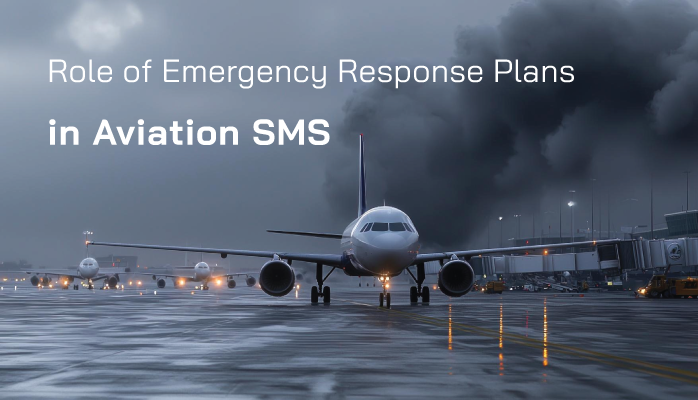How to Conduct Root Cause Analysis

In the aviation industry, both safety and profits are paramount. With millions of flights operating globally each year, the need for robust safety protocols cannot be overstated.
One critical component of an effective Aviation Safety Management System (SMS) is the Emergency Response Plan (ERP). ERPs are meticulously designed frameworks that ensure rapid, coordinated, and effective responses to emergencies, minimizing risks to
- human life,
- real property,
- operator's assets, and
- the environment.
This article explores the pivotal role ERPs play in aviation safety, their key components, regulatory requirements, and their impact on operational resilience.
Understanding Emergency Response Plans in Aviation SMS
An ERP is a structured set of procedures that aviation organizations—airlines, airports, and air traffic control facilities—implement to manage and recover from crises such as
- aircraft accidents,
- medical emergencies,
- security threats,
- fires, or
- natural disasters.
Unlike routine operational processes, ERPs are activated during high-stakes, time-sensitive situations where standard procedures are insufficient. Their primary goal is to:
- mitigate the consequences of an emergency,
- protect lives, and
- ensure a swift return to normal operations.
ERPs are a cornerstone of the Safety Management System, a systematic approach to managing safety risks mandated by the International Civil Aviation Organization (ICAO). The SMS integrates proactive, predictive, and reactive safety measures, and ERPs serve as the reactive arm, addressing incidents that could not be prevented.
Why ERPs Are Critical to Aviation Safety
- Rapid Response Saves Lives: In emergencies like aircraft crashes, fires or onboard medical incidents, every second counts. A well-executed ERP ensures that first responders, medical teams, and authorities are mobilized instantly, reducing fatalities and injuries.
- Minimizes Operational Disruptions: Emergencies can disrupt flight schedules, airport operations, and passenger confidence. ERPs streamline crisis management, enabling organizations to recover operational effectiveness quickly.
- Regulatory Compliance: ICAO’s Annex 19 and national aviation authorities, such as the Federal Aviation Administration (FAA) or European Union Aviation Safety Agency (EASA), mandate ERPs as part of SMS requirements. Non-compliance can lead to penalties or operational restrictions.
- Enhances Stakeholder Confidence: Passengers, employees, and investors trust organizations that prioritize safety. A robust ERP demonstrates an airline or airport’s commitment to preparedness, bolstering its reputation.
Related Emergency Response Plan Articles
- What Emergency Response Plans Are (and Why You Need It)
- What Your Emergency Response Plan Should Include
- Steps to Create an Emergency Response Plan in Aviation SMS [With Free Checklists]
Key Components of an Effective ERP

An ERP is only as effective as its design and execution. Below are the essential elements that make an ERP impactful within an aviation SMS:
1. Clear Roles and Responsibilities
Every stakeholder—from pilots and cabin crew to ground staff and external agencies—must understand their role during an emergency. ERPs outline a chain of command, ensuring decisions are made swiftly and without confusion. For example, the Incident Commander oversees operations, while communication teams liaise with the media and families.
2. Comprehensive Risk Assessment
ERPs are tailored to specific risks identified through the SMS’s hazard identification process. For instance, an airport near a seismic zone might prioritize earthquake response, while a coastal facility may focus on tsunami preparedness.
3. Communication Protocols
Effective communication is the backbone of every emergency response. ERPs establish internal and external communication channels, including hotlines, radio systems, and digital platforms. They also include templates for public statements to manage media and public perception.
4. Training and Drills
Regular training ensures personnel are familiar with ERP procedures. Simulated drills, such as mock aircraft crashes or evacuation exercises, test the plan’s efficacy and identify gaps. ICAO recommends conducting full-scale emergency exercises at least every two years.
5. Coordination with External Agencies
Aviation emergencies often require collaboration with local fire departments, hospitals, law enforcement, and government agencies. ERPs include pre-established agreements to ensure seamless coordination during crises.
6. Post-Incident Review
After an emergency, ERPs mandate a thorough debriefing to evaluate the response’s effectiveness. Lessons learned are integrated into the SMS, fostering continuous improvement. SMS Pro includes a Lessons Learned Library suitable for crafting and publishing ERP Lessons Learned.
Regulatory Framework Governing ERPs
The global aviation industry operates under stringent safety regulations, with ERPs being a key compliance requirement. ICAO’s Annex 14 (Aerodromes) and Annex 19 (Safety Management) provide guidelines for ERP development. Key regulatory aspects include:
-
ICAO Standards: Airports and airlines must maintain ERPs that address aircraft accidents, fires, hazardous material spills, and security incidents.
-
National Oversight: Authorities like the FAA require annual ERP reviews and updates to reflect operational changes or new risks.
-
Documentation: ERPs must be documented, accessible, and regularly audited to ensure compliance.
Failure to adhere to these standards can result in operational bans, fines, or loss of certification, underscoring the ERP’s importance in regulatory compliance.
Related Regulatory Compliance Articles
- Why Documentation in Aviation SMS Is Important - Beyond Compliance
- What Continuous Improvement Compliance Looks Like in Real SMS
- How to Bring Your Aviation Safety Reporting System to Compliance?
Real-World Impact of ERPs
The effectiveness of ERPs is evident in real-world aviation incidents. For instance, during the Hudson River landing of US Airways Flight 1549 in 2009, the airline’s ERP facilitated a swift response. The crew’s training, coupled with coordinated efforts from the airline, coast guard, and local authorities, ensured all 155 passengers and crew were safely evacuated. This incident highlights how ERPs can turn potential tragedies into stories of resilience.
Conversely, inadequate ERPs can exacerbate crises. The 2018 Lion Air Flight 610 crash revealed gaps in post-incident response, including delays in family notifications and media mismanagement, which damaged the airline’s reputation. Such cases emphasize the need for robust, well-tested ERPs.
Challenges in ERP Implementation
Despite their importance, developing and maintaining ERPs is not without challenges:
-
Resource Constraints: Smaller airlines or airports may lack the budget for comprehensive training or advanced equipment.
-
Coordination Complexity: Aligning multiple stakeholders, especially across jurisdictions, can be logistically challenging.
-
Evolving Risks: New threats, such as cyberattacks or pandemics, require ERPs to be continually updated.
-
Human Factors: Stress, fatigue, or inadequate training can undermine ERP execution during real emergencies.
To address these challenges, aviation organizations must invest in modern database technology, foster a safety culture, and leverage SMS data to refine their ERPs. For example, SMS Pro's ERP module significantly reduces time to manage ERP documentation, as well as their integrated Emergency Drills module to document ERP exercises and lessons learned.
The Future of ERPs in Aviation Safety
As the aviation industry evolves, so do the demands on ERPs. Emerging trends are shaping the future of emergency response within aviation SMS:
- Technology Integration: Drones, AI, and real-time data analytics are enhancing situational awareness during emergencies. For example, AI can predict the spread of fires, enabling faster containment.
- Sustainability Focus: ERPs are increasingly addressing environmental impacts, such as fuel spills or carbon emissions during rescue operations.
- Global Collaboration: International partnerships are improving cross-border emergency response, especially for incidents involving multiple countries.
- Pandemic Preparedness: The COVID-19 pandemic highlighted the need for ERPs to include health crisis protocols, such as passenger screening or quarantine measures.
Conclusion
Emergency Response Plans are the linchpin of Aviation Safety Management Systems, ensuring that organizations are prepared to handle crises effectively. By combining clear procedures, rigorous training, and regulatory compliance, ERPs save lives, protect assets, and maintain public trust.
As aviation faces new challenges—from technological disruptions to environmental concerns—ERPs will continue to evolve, reinforcing their indispensable role in safety management. For airlines, airports, and regulators, investing in robust ERPs is not just a regulatory obligation but a moral imperative to safeguard the skies.
Need help managing your ERP and supporting documentation? SMS Pro can help ease your pain points.






